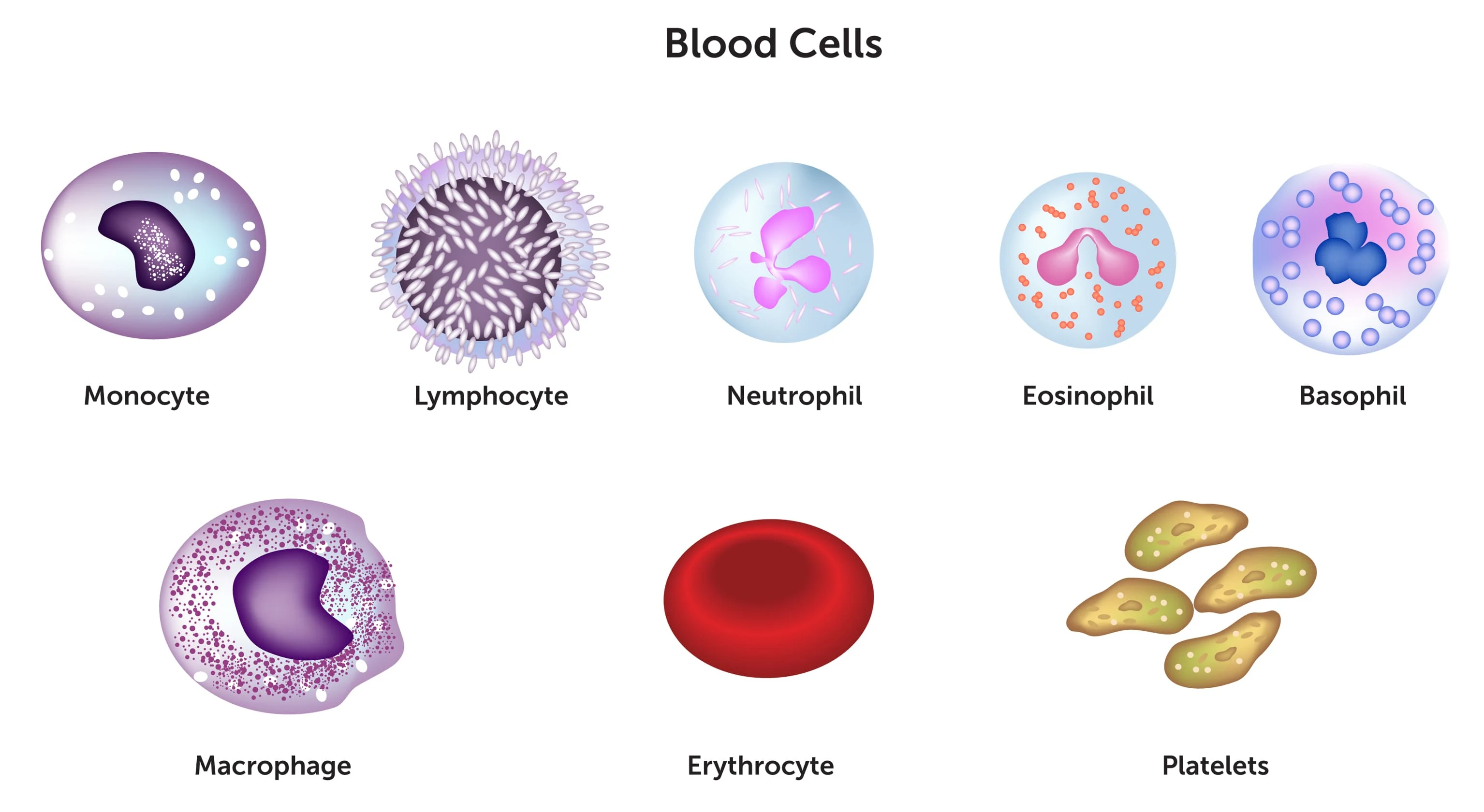Immunology is a relatively new science which has always been linked to the science of microbiology because the main function of the immune system is to combat infections caused by different microbes.
The immune system is composed of the leucocytes (granulocytes, monocytes and lymphocytes), as well as a number of lymphoid organs.
Components of the Immune System:
a. Cells of the Immune System
Following is a brief description of the role of each cell in the immune response:
- Neutrophils are phagocytic cells that are capable of engulfing and digesting foreign agents.
- Eosinophils are mainly of importance in defence against helminthic parasites.
- Basophils are found in the blood in very low concentrations and play a very important role in allergic reactions.
- Mast cells are similar to basophils but are found in tissues.
- Monocytes/Macrophages: Monocytes are present in the blood and continuously leave it to go to the tissues where they complete their maturation and become macrophages. They are phagocytic and have other properties important for the immune system.
- Dendritic cells are phagocytic cells of the innate immune system and act as an important bridge between it and the adaptive immune system.
- Lymphocytes include T and B lymphocytes as well as natural killer (NK) cells.
Table 2: Comparison of T and B Lymphocytes
| Characteristic | T lymphocytes | B lymphocytes |
|---|---|---|
| Production | Both are produced in the bone marrow | In the bone marrow and lymph tissue |
| Maturation | In the thymus | In the bone marrow |
| Count | Comprise 75% of peripheral blood lymphocytes (PBLs) | Comprise 10% of PBLs |
| Functions | Cell-mediated immunity, including: | Humoral immunity, including: |
|
|
|
| Receptors | T cell receptor (TCR): | B cell receptor (BCR): |
|
|
- Natural Killer (NK) cells: are large granular lymphocytes which can be distinguished from B and T lymphocytes. They constitute 10-15% of peripheral blood lymphocytes. They are capable of killing abnormal body cells.
b. The Lymphoid Organs
The lymphoid organs are organized tissues where lymphocytes interact with other non-lymphoid cells that are important either in their maturation or in starting an acquired immune response. They are divided into:
I. Primary (central) lymphoid organs
This is where lymphocytes complete their maturation, becoming mature (adult) lymphocytes. They are:
- The bone marrow: where the B cells complete their maturation. (Thus, the bone marrow is not only the place of origin of all blood cells, but also acts as a central lymphoid organ).
- The thymus: where the T cells complete their maturation.
II. Secondary (peripheral) lymphoid organs
They are the places where B and T lymphocytes can meet antigens, leading to activation of the lymphocytes.
The secondary lymphoid organs include the spleen, lymph nodes and various mucosal associated lymphoid tissue (MALT):
- The lymph nodes are highly organized structures distributed all over the body.
- The spleen is mainly composed of red pulp, which is the site of RBC disposal, whereas the white pulp contains the lymphocytes.
- The gut-associated lymphoid tissue (GALT) includes the tonsils, adenoids, appendix and Peyer's patches.
- The bronchial-associated lymphoid tissue (BALT) includes similar but more diffusely organized collections of lymphocytes which protect the respiratory epithelium.
- Other mucosal sites contain similar collections.
Circulation of Lymphocytes between Blood and Lymph
1. Small B and T lymphocytes that have matured, but have not yet met antigen, are
called naïve lymphocytes.
They leave the bone marrow and thymus, respectively and circulate continually from the blood into secondary lymphoid organs, such as the lymph nodes, until they meet antigen or die.
2. Microbial antigens are drained from the site of infection through the afferent lymphatic vessels into the lymph nodes.
Not any lymphocyte seeing an antigen will recognize it. This is because lymphocytes are very specific for the antigens they recognize.
Lymphocytes which recognize a certain antigen undergo a series of changes which make them ready to start working against the antigen to which they are specific.
The changes which occur are:
a. Activation: They become lymphoblasts.
b. Proliferation: They multiply rapidly.
c. Differentiation: They change into effector cells, capable of being effective
against the invading agent:
- B cells change into plasma cells, capable of secreting antibody.
- Cytotoxic T cells and helper T cells become effector cytotoxic T cells and effector helper T cells respectively.
 |
| Fig. 1: Circulation of lymphocytes between blood and lymph |
3. They now leave the lymph nodes through the different lymphatic vessels and return to the blood through the thoracic duct. From the blood, they reach the peripheral tissues where they start functioning to eliminate the specific infection which started their activation.
Some of the antigen-specific lymphocytes produced by these events remain after the antigen has been eliminated.
These are called memory cells and are the basis of immunological memory which ensures a more rapid and effective response on a second meeting with the same pathogen and therefore gives long lasting immunity. Immunological memory is the most important biological sequence of the development of acquired immunity.
The Clonal Selection Theory
⚫ As mentioned above, T and B lymphocytes recognize antigen by very specific receptors present on their surface. Every naïve lymphocyte has a single type of receptor of certain specificity.
Only those lymphocytes which meet the antigen which their receptors recognize will undergo activation, proliferation and differentiation.
The result is a clone (family) of identical daughter cells, all having identical receptors, which can bind the same antigen wherever they find it. Thus, antigen specificity is maintained in the daughter cells.
The clonal selection theory is so-called because a certain clone of cells is selected from the pool of naïve lymphocytes.
⚫ Lymphocytes having receptors specific for self molecules (a person's own molecules) are normally deleted at an early stage in lymphoid cell development and are, therefore, absent from the pool of mature lymphocytes.
